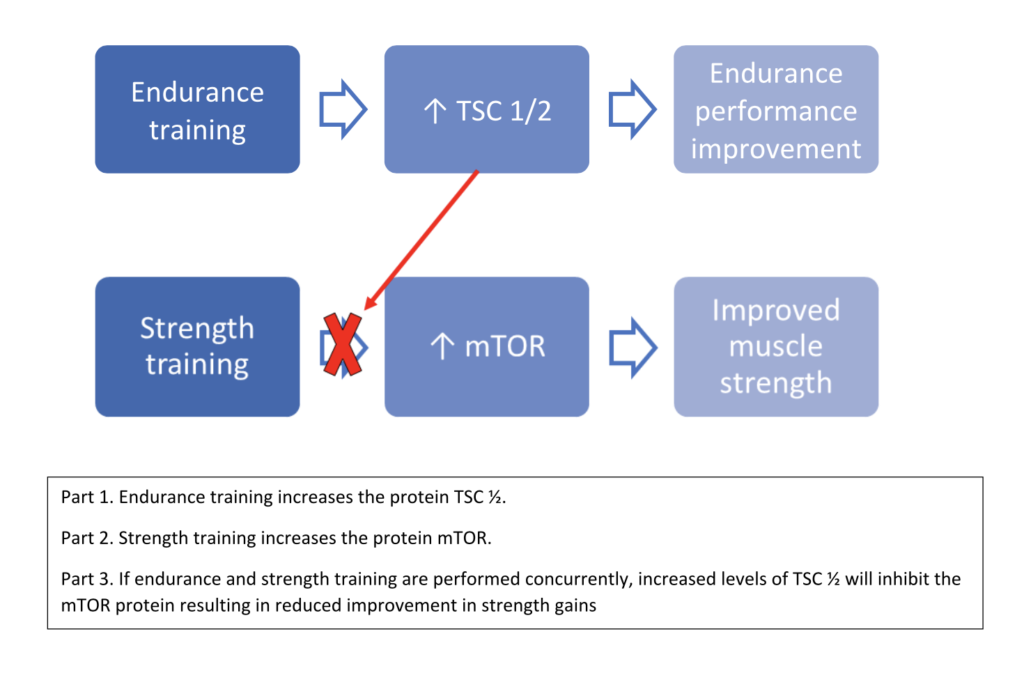
16 Feb Running or Lifting Weights? Yes, to both.
Todd Buckingham, Ph.D. | Lead Exercise Physiologist, Mary Free Bed Sports Rehabilitation
Should I run then lift weights or lift weights then run?
This is such a great question and one that I get all the time. Both from runners and strength athletes. The answer is a bit more nuanced than “run” or “lift” and deserves further explanation. Whether you run or lift first all depends on your goals.
If your goal is to gain strength, lift weights and then run.
Lift weights and then run…but don’t run on the same day.
Endurance training inhibits the adaptations you get from strength training. And that’s regardless of whether you run before OR after your weightlifting session. So, to get the most out of your strength training, you should do cardio on a different day than your weightlifting session.
The reason for this is due to a protein called TSC ½. Endurance training (like running) increases the amount of TSC ½ in the muscle. This TSC ½ protein suppresses another protein that is stimulated after lifting weights called mTOR. mTOR is responsible for increasing protein synthesis and increasing muscle size after your weightlifting session. But if you have high levels of the TSC ½ protein, the mTOR protein is suppressed. SO, if mTOR is suppressed, you won’t get the same muscle growth as if you didn’t run. And if you don’t get that muscle growth, you won’t gain as much strength as you could have. This point is illustrated in the figure seen here.

If your goal is to get the most out of your run, run first.
Running is the main objective, so run and then lift.
Lifting weights doesn’t inhibit your endurance adaptations like endurance training inhibits your strength adaptations. BUT lifting weights prior to your run is still not ideal if you want to get the most out of your run.
When your goal is to get the most out of your run, run first. The run is more important than the lift so you should run first to prioritize the benefits you get from running. Lifting weights first will cause your muscle fibers to become fatigued. If your goal is to get the most out of your run, starting with fatigued muscles is not the way to go. You want to be as fresh as possible to receive the best adaptations possible.
The reason lifting weights causes fatigue is that it creates micro-tears in the muscle fibers. This results in 2 things that will inhibit your run: 1. The damaged muscle fibers won’t be able to contract as readily because…well, they are damaged. This limits the available muscle fibers your body has to call upon when you set out for your run and 2. The micro-tears cause calcium to leak from your muscle which then collects in the mitochondria of the muscle. The problem with this is that the mitochondria are where we make ATP (energy) and calcium inhibits the ATP production. Inhibited ATP production means less energy available for the run meaning the run will feel harder and you may not be able to go as long or as fast.

HOWEVER! If your goal is to simulate the end of a race when your legs are tired and heavy, lift first, then run.
This can be particularly useful for marathon/ultramarathon runners or long-distance triathletes. Let’s take a marathon runner, for example. In training, rarely (if ever) will you run a full 26.2 miles. And you really shouldn’t run a full marathon in training to prepare for your race because the risks outweigh the reward…I’ve talked about this before on my Instagram, so if you don’t follow me, you should! (@toddbuckone). But there is really no way to simulate the end of a marathon without running a marathon, right? WRONG!
An example of this would be to lift weights for an hour prior to going out for a long run. So at the end of your long 18-mile run, you will have similar muscle damage to the end of a marathon without running an entire marathon. The benefit of doing this is that you’re not putting the extra stress on your bones and joints that you would if you were to run 26 miles. BUT your muscles are still getting the same adaptations you would if you were to run 26 miles.
If your goal is to get the most out of both, leave at least 8 hours between sessions to maximize adaptations.
Like we discussed previously, strength training doesn’t inhibit endurance gains, but endurance training can inhibit strength gains. Therefore, if you want to do both, make sure you leave plenty of time (~3-6 hours) between weightlifting and running sessions.
Now why do you have to do your weightlifting session 3-6 hours before OR after your run? Well, the adaptations you get from weightlifting won’t occur immediately after your lift is complete. If you lift and then run (or run then lift), the TSC ½ protein will impair the strength gains you get. Notice how I said “impair” and not “completely neutralize” the gains. Therefore, it’s important to keep a few hours (~3-6) between strength and endurance training sessions to allow the TSC ½ protein levels to decrease when the goal is to maximize the adaptations from lifting weights.
This is an EXTREMELY complex situation and hard to boil down to a simple blog post that’s applicable to everyone. That’s why the best answer is always “it depends”. It depends on the goals of your run. It depends on the goals of your lift. It depends where you are in your training cycle. It depends on how well-trained you are. It depends on what color your eyes are. Okay, maybe not that last one haha. But it really does depend on a LOT of different factors and there is no one-size-fits-all answer to this question. But hopefully, these guidelines give you a better idea the next time you ask yourself “should I run or lift weights first?”